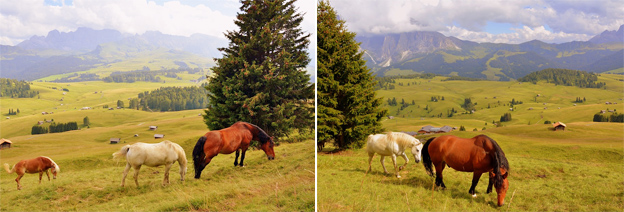Walking Near Livestock
What should you do if you encounter livestock on your countryside walk? We offer these considerations and strategies.
Walking Near Livestock
https://www.contours.co.uk/walking-near-livestock
by Nicky Jaquiery
"A recent experience with cows got me thinking about what we should do when we encounter livestock while on a walk."

During a recent walk in the Dolomites we came across grazing livestock who wander freely in the high mountain pastures during the summer months. The bells worn around the cows' necks meant that you frequently heard them before you saw them. I often mused to myself how annoying it must be for the cows to have a bell permanently attached to them, with no escape from the constant tinkling noise! Anyway, I digress. The point is that these cows seemed perfectly content chewing the cud, that is until one of my friends decided to approach what he thought seemed a friendly-looking cow to take a close-up photo. Neither he nor I were prepared for the cow to start charging him, and needless to say we made a quick exit to safety. After this we were more cautious around local livestock and gave the cows, horses and donkeys a wide berth.
Our experience in the Dolomites got me thinking about what we should do when we encounter livestock while on a walk here in the UK. In my last article I focused on walking with a dog and the Dog Walking Code. Here I’m going to review the Countryside Code as it relates to cattle and horses, since these are the types of livestock that we are most likely to come across.
When I think of charging animals, I automatically think of bulls. As far as bulls are concerned, it is the responsibility of farmers to ensure that walkers are not exposed to unnecessary risks when walking on rights of way. This means that it is against the law for bulls over 10 months old to be on their own in a field crossed by a public right of way. It is also an offence to keep a bull of a recognised dairy breed, even if the bull is accompanied by cows or calves, on land crossed by a public right of way. It is up to farmers to do what they can to minimise the risks to walkers by putting up signs alerting people to the fact that there is a bull in the field.
Most of us are aware of the danger associated with bulls, but few people realise that cows can be just as dangerous at certain times of year, for example in the Spring when cows are with their newly born calves. As with bulls, farmers are advised to erect signs informing people that there are cows with calves in a field.
As walkers we want to enjoy our time in the countryside without having to worry about cattle on or near our path. So, if you do come across cattle, what should you do? The general advice is to use your common sense and avoid any behaviour that could be interpreted as threatening. Follow the advice below and you should have a safe and enjoyable walk:
In the case of horses, it’s best to be cautious in the same way as with cattle. It’s not uncommon to come across horse riders on bridleways and although they don’t have priority over walkers, be mindful of the fact that horses are much bigger than you and can do you a lot of damage!
If you encounter a horse that behaves aggressively or chases you, report the incident to the local authority.
Outdoors Enthusiast
Nicky Jaquiery is a frequent contributor to the Contours Holidays blog, tapping into her vast experience out in the countryside as walker and runner to produce thoughtful and practical articles.